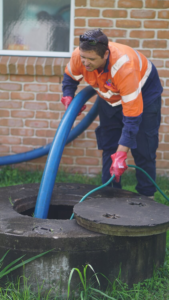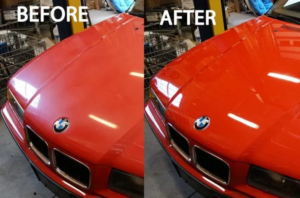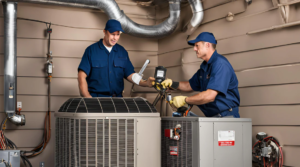Gutters play a key role in keeping your home safe and healthy. They collect rainwater from the roofline and direct it away, preventing damage to your home’s foundation and avoiding basement flooding.

They also help prevent mildew, rot, and mold, and keep water from pooling around the house. Investing in proper gutter installation and maintenance is critical to protect your home. Contact Gutter Installation Greensboro for professional help.
Gutters are an often-overlooked part of your home’s protective infrastructure, but they’re a vital defense against costly water damage. They are designed to collect and channel rainwater away from your roof and foundation, safeguarding your home from soil erosion, basement flooding, mold growth, and siding damage. When installed correctly, a well-functioning gutter system can prevent these problems by diverting rainwater at least six feet from the foundation and directing it to designated areas like storm drains or landscaping.
However, if gutters aren’t angled or anchored properly, they can fall off or become clogged. This can lead to the very water damage that gutters are meant to prevent, resulting in standing water, leaks, and even rotting fascia boards. Fortunately, professional installation ensures your gutters are perfectly positioned to deliver optimal functionality and safety.
Aside from avoiding costly repairs, gutters also enhance your home’s curb appeal and can increase its value if you choose to sell in the future. Aesthetics aren’t the only benefit, as a well-functioning gutter system can help avoid pest infestations by preventing clogged gutters.
Many homeowners are faced with the question of whether to tackle DIY gutter installation or hire professionals. While the allure of saving money may be tempting, the complexity of gutter installation and the risk of errors that can cost you more in the long run make it a wiser choice to leave it to the experts. In this blog post, we explore the intricacies of the gutter installation timeline and provide insights into why entrusting the job to a professional is essential for ensuring quality results and longevity.
Prevents Water Damage
Gutters are the silent guardians of your home, protecting against costly damage. They collect rainwater and direct it away from vulnerable areas, such as the foundation and basement. But improper gutter installation can result in expensive water damage.
If you’ve been experiencing a variety of problems, such as leaking windows and walls, peeling paint, and mold and mildew growth, it’s likely because your gutters aren’t working properly. Regular gutter inspections, cleaning, and maintenance help prevent these problems and keep your house in top condition.
Gutter debris can clog your gutters, preventing water flow. When this occurs, it can cause overflowing and water damage to your roof, walls, foundation, landscaping, and more. Clogged gutters can also lead to soil erosion, which can damage the foundation of your home and weaken its structural integrity.
A professional gutter installer ensures that your downspouts are positioned to efficiently direct rainwater away from your house. Downspouts that are too short or incorrectly placed can cause water to pool near the foundation of your home, causing soil erosion and potentially damaging your basement or crawl space.
Additionally, downspout extensions and splash blocks can be installed to help direct rainwater further away from your foundation. These accessories are a great addition to any gutter system and can significantly reduce your risk of water damage. You can also invest in ice dam prevention, which prevents melted snow from building up in your gutters and blocking the flow of water during inclement weather. These simple upgrades can save you a lot of money in the long run.
Avoids Clogs and Leaks
Gutters collect rainwater and direct it away from your home, protecting the siding, walls, foundation, and paint. They also prevent the buildup of organic materials that can cause mold and mildew, which can be dangerous to health. However, they are not maintenance-free; they require regular inspections and cleaning. If you see signs of clogs or leaks, it’s important to take action quickly to prevent further damage to your home and expensive repairs.
One of the most common causes of gutter clogs is a lack of proper downspout placement. A professional will install downspouts in the correct position to ensure that water flows out and away from your house, avoiding basement flooding, foundation problems, and soil erosion.
Another common issue is a lack of a proper gutter slope. This is important because a gutter with the incorrect slope can overflow, which can damage your roof and fascia. A professional will correctly install your gutters with the ideal slope to keep water flowing properly, preventing damage and clogs.
Another way to avoid clogs and leaks is to use gutter guards. These are metal inserts that cover your gutter downspouts to stop debris from getting into them and clogging the system. They are available in a variety of styles and colors to match your home’s decor. In addition, they help prevent rust and can save you from having to clean your gutters as frequently. A good quality gutter protection system is worth the investment to reduce your maintenance costs and time spent on cleaning your gutters. It’s also important to regularly check and maintain your gutter system to make sure it is functioning properly. Signs of damage like rust spots, overflowing, or visible seams and leaks can indicate that your gutters aren’t sealing correctly.
Longevity
Investing in your gutter system now can save you money in the long run. Gutter installation protects the foundation, basement, and exterior of your home, keeping it safe and looking good. It can also prevent costly repair and maintenance costs down the road. Gutter longevity is enhanced by regular maintenance and proper installation, which is why you should always work with experienced professionals to ensure your gutters perform well for many years.
Gutter installation requires accurate measurements of your roof and the overall structure of your house. This is why it’s important to use a roofing contractor who is familiar with the local weather and building conditions. They will be able to determine the best location for downspouts and the optimal angle for water flow.
Once the measurements have been made, your roofing contractor can start to gather the materials for the project. They will need to know the total linear feet of guttering that you require, as well as your choice of material. There are several options to choose from, including aluminum, steel, and copper. Each material offers different benefits, but the decision may come down to your personal preferences and budget.
Once the materials are gathered, your roofing contractor will begin to install your new gutters. They will measure the length of each section and determine how many downspouts are needed. They will also ensure the gutters are installed at a slope to allow for water flow and drainage. This is known as the “gutter slope.” This is an important step, as it ensures your gutters will function properly over time.
Safety
Homeowners who take pride in maintaining their homes often tackle do-it-yourself (DIY) projects to save money and improve the property. Gutter installation is one such task that homeowners can attempt themselves, but it poses significant safety risks if not executed properly. It’s important to understand these dangers and when it is best to call in the experts.
Injury Risks: The most common gutter installation injuries involve falls from ladders or roofs. Taking the time to prepare the work area by clearing debris and making sure the ladder is stable before beginning work reduces this risk significantly. Also, wearing proper protective gear such as gloves, safety goggles, and a hard hat prevents cuts to the hands and eyes from sharp debris and falling objects respectively. Hydration is also key, as workers are likely to be outside in hot weather.
Musculoskeletal Strain: Working at heights and in tight spaces can strain the muscles and joints, leading to long-term discomfort or even injuries. Gutter installation requires bending, reaching, and lifting heavy materials, which can result in prolonged pain or even damage to the back, shoulders, or neck.
Other potential injuries include improper use of tools and disregarding ladder usage protocols, such as keeping the body’s center of gravity within the side rails to prevent tipping. Inaccurate measurements or misaligned gutters can also lead to costly errors. Careful planning and the use of measuring tools like a tape measure, level, chalk line, and markers helps ensure precise dimensions and alignments. This reduces the need for rework and prevents costly mistakes during installation. Downspout outlets should be cut with precision, as well, to ensure efficient drainage. This prevents water pooling and keeps the foundation of the building safe from premature deterioration.








